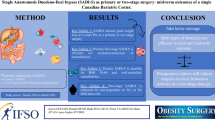Abstract
Background
Gastric sleeve resection was initially planned as the first step of bilio-pancreatic diversion with duodenal switch but it continues to emerge as a restrictive bariatric procedure on its own. We describe intermediate results in a series of 126 laparoscopic sleeve gastrectomies (LSG) compiled from three bariatric centers in eastern Austria.
Methods
The stomach was laparoscopically reduced to a “sleeve” along the lesser curvature over a 48-Fr bougie. Special attention was placed on complete resection of the gastric fundus.
Results
After a mean follow-up of 19.1 months, patients had lost between 2.3 and 27 kg/m2 or between 6.7% and 130% of their excessive weight. Sixty four percent of the patients lost >50% of their excess weight within an average of 20 months. Seven percent of the patients had an excess weight loss <25% and were therefore considered as failures. The only major surgical complication was leakage of the staple-line needing revision (three times). There were no operative mortalities.
Conclusion
The final place of LSG in bariatric surgery is still unclear, but our results and those of others show that LSG can be a viable alternative to established procedures.


Similar content being viewed by others
References
Foster-Schubert KE, Cummings DE. Emerging therapeutic strategies for obesity. Endocr Rev. 2006;27:779–93.
Samuel I, Mason EE, Renquist KE, et al. Bariatric surgery trends: an 18-year report from the international bariatric surgery registry. Am J Surg. 2006;192:657–62.
Cottam D, Qureshi FG, Mattar SG, et al. Laparoscopic sleeve gastrectomy as an initial weight-loss procedure for high-risk patients with morbid obesity. Surg Endosc. 2006;20:859–63.
Regan JP, Inabnet WB, Gagner M, et al. Early experience with two-stage laparoscopic Roux-en-Y gastric bypass as an alternative in the super-super obese patient. Obes Surg. 2003;13:861–4.
Silecchia G, Boru C, Pecchia A, et al. Effectiveness of laparoscopic sleeve gastrectomy (first stage of biliopancreatic diversion with duodenal switch) on co-morbidities in super-obese high-risk patients. Obes Surg. 2006;16:1138–44.
Mognol P, Chosidow D, Marmuse JP. Laparoscopic sleeve gastrectomy as an initial bariatric operation for high-risk patients: initial results in 10 patients. Obes Surg. 2005;15:1030–3.
Hamoui N, Anthone GJ, Kaufman HS, et al. Sleeve gastrectomy in the high-risk patient. Obes Surg. 2006;16:1445–9.
Roa PE, Kaidar-Person O, Pinto D, et al. Laparoscopic sleeve gastrectomy as treatment for morbid obesity: technique and short-term outcome. Obes Surg. 2006;16:1323–6.
Carmichael AR, Johnston D, Barker MC, et al. Gastric emptying after a new, more physiological anti-obesity operation: the magenstrasse and mill procedure. Eur J Nucl Med. 2001;28:1379–83.
Langer FB, Bohdjalian A, Felberbauer FX, et al. Does gastric dilatation limit the success of sleeve gastrectomy as a sole operation for morbid obesity? Obes Surg. 2006;16:166–71.
Dixon JB, McPhail T, O’Brien PE. Minimal reporting requirements for weight loss: current methods not ideal. Obes Surg. 2005;15:1034–9.
Lee C, Cirangle P, Jossart G. Vertical gastrectomy for morbid obesity in 216 patients: report of two-year results. Surg Endosc. 2007;21:1810.
Himpens J, Dapri G, Cadiere GB. A prospective randomized study between laparoscopic gastric banding and laparoscopic isolated sleeve gastrectomy: results after 1 and 3 years. Obes Surg. 2006;16:1450–6.
Baltasar A, Serra C, Perez N, et al. Re-sleeve gastrectomy. Obes Surg. 2006;16:1535–8.
Gagner M, Rogula T. Laparoscopic reoperative sleeve gastrectomy for poor weight loss after biliopancreatic diversion with duodenal switch. Obes Surg. 2003;13:649–54.
Milone L, Strong V, Gagner M. Laparoscopic sleeve gastrectomy is superior to endoscopic intragastric balloon as a first stage procedure for super-obese patients (bmi > or =50). Obes Surg. 2005;15:612–7.
Melissas J, Koukouraki S, Askoxylakis J, et al. Sleeve gastrectomy a restrictive procedure? Obes Surg. 2007;17:57.
Langer FB, Reza Hoda MA, Bohdjalian A, et al. Sleeve gastrectomy and gastric banding: effects on plasma ghrelin levels. Obes Surg. 2005;15:1024–9.
Gagner M, Gumbs A. Gastric banding: conversion to sleeve, bypass, or ds. Surg Endosc. 2007;21:1931.
Dixon J. Survival advantage with bariatric surgery: report from the 10th international congress on obesity. Surg Obes Relat Dis. 2006;2:585–6.
Author information
Authors and Affiliations
Corresponding author
Rights and permissions
About this article
Cite this article
Felberbauer, F.X., Langer, F., Shakeri-Manesch, S. et al. Laparoscopic Sleeve Gastrectomy as an Isolated Bariatric Procedure: Intermediate-Term Results from a Large Series in Three Austrian Centers. OBES SURG 18, 814–818 (2008). https://doi.org/10.1007/s11695-008-9483-1
Received:
Accepted:
Published:
Issue Date:
DOI: https://doi.org/10.1007/s11695-008-9483-1




